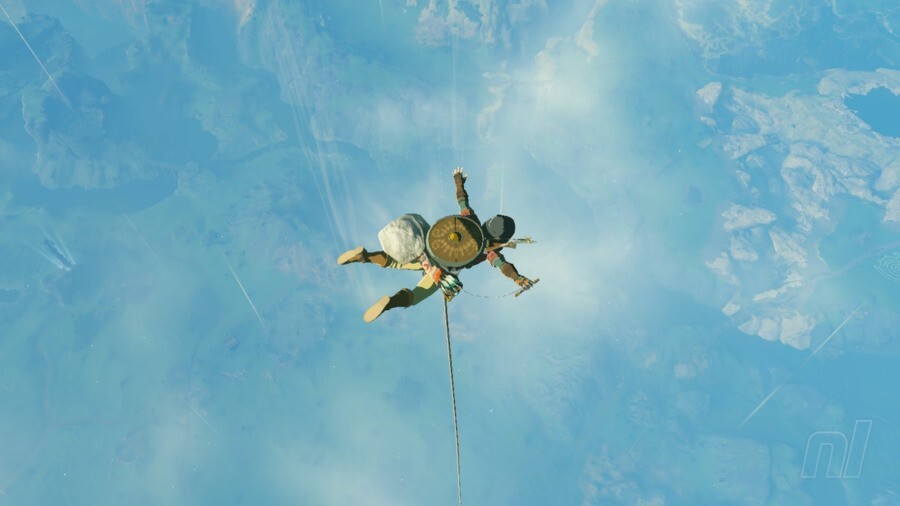

The Legend of Zelda: Tears of the Kingdom has been a critical and commercial success, garnering glowing reviews across the board (including from this here outlet) and making a lot of Switch owners very happy in the process. All that praise is thoroughly well-deserved, but with several AAA developers and publishers slowly but steadily upping their game when it comes to including thorough accessibility options, we wondered how Nintendo’s latest hit ranks in those terms.
We’ve previously looked at various Nintendo titles from an accessibility perspective, and now it’s TOTK’s turn. Over to Hilliard…
There was a fairly loud group of people proclaiming that Tears of the Kingdom was nothing more than glorified $70 DLC for Breath of the Wild. It was all irrational based on fear that the game couldn’t live up to the hype (or hatred that the game wouldn’t be like the 50th reiteration of the Zelda template established by A Link to the Past). I knew they were being ridiculous but I’m not going to lie and say I didn’t fear that Tears of the Kingdom would do something exactly the same as its predecessor.

The big difference was that my fear was justified. I was afraid that Tears of the Kingdom would not have any accessibility features. Prior to launch, I said I would dye my hair Nintendo’s signature red if the game included something as simple as in-game button remapping. Instead, I buzzed it all off.
I was paralyzed about 14 years ago (C5/C6 tetraplegic), so I have a pretty good understanding of Nintendo’s feelings about adding accessibility features to their games. They just aren’t going to do it.
Why has the organization and its developers taken this stance? I can’t read minds like Professor X so I don’t know the answer (I am balding though). Maybe a wheelchair user accidentally ran over Eiji Aonuma’s foot and this is his way of getting vengeance? It’s got to be something like that because Aonuma knows this is an issue. Read this exchange with Jason Schreier when asked why button remapping wasn’t in Breath of the Wild in a piece that Kotaku ran on June 2019:
Aonuma: When we have a button arrangement, we very much put thought into how we do it, because there’s a specific way we want players to feel. In some ways, if we freely let players do customizations on key assignments and such, I feel like we’re letting go of our responsibility as a developer by just kind of handing everything over to the users. We have something in mind for everybody when we play the game, so that’s what we hope players experience and enjoy as well. But we understand also that players have a desire for free customization.
Schreier: Also, physically disabled players might not be able to play the way developers intended.
Aonuma: Definitely, that’s a very good point, and that’s something we’ll keep in mind going forward, thinking about that.
Aonuma acknowledges but brushes the point aside, and ended up doing nothing. Take a look at what your peers are doing, Aonuma-san. Sony, Microsoft, and every major developer are doing the equivalent of installing a push-button door opener while you are parking your car in a handicap unloading zone.

I don’t want to read another press release stating “Nintendo endeavours to provide products and services that can be enjoyed by everyone” which is what the company said after criticism from AbleGamer’s Steven Spohn in 2021. Either be honest and say you will continue leaving disabled people out in the cold or join the accessibility revolution.
The corporations that are adding accessibility features to their products aren’t just doing this out of the goodness in their heart, by the way. They do it for good PR and to tap into an underserved market.
My Experience Playing Tears of the Kingdom

All of that said, I am still able to play Tears of the Kingdom relatively well. I can’t move my fingers but when I plop my pro controller on my leg, I can fiddle the joysticks with my palms and jam the face buttons with my right thumb very easily.
Sometimes the controller starts sliding around but the game allows you to pause whenever you want so I can re-adjust as much as I need. The shoulder buttons are pressable with my knuckles but that requires me to take my left hand away from the joystick and my right from the face buttons. So that means I am unable to lock on to any enemy unless I keep Link still. Obviously, that is not ideal so finding a solution to that was my main priority when remapping the controls in the Switch’s settings. This is the setup I created:
By moving ‘ZL’ to ‘A’, I am able to lock onto an enemy and still move Link around. This move also benefits me since I have the ability to press two face buttons at the same time. That means I can still attack as well as perform jump dodges. Hitting ‘Y’ (attack) while holding ‘A’ is a struggle so I moved it to ‘B’. I rarely feel the need to target while using the bow so moving it to ‘Y’ from ‘ZR’ works pretty well.
Moving ‘A’ and ‘B’ to the left and right bumpers respectively is odd and by far the leading cause for me pressing the wrong button, but switching their position is not without its merits. Shield parrying with ‘L’ isn’t an issue because Link doesn’t need to be moving to do it and I was already used to using ‘R’ to sprint thanks to playing Dragon Quest XI (the best RPG on Switch in my humble opinion). The only issue is tapping ‘L’ to grab things while I’m moving Link. If I need to do that, like when I’m trying to catch a bug, I reach across with my right hand so I don’t have to take my left off the joystick.
The only thing I couldn’t make easier on myself is using the D-pad. I can still swap weapons and shields by entering the menu but pressing up is the only way to fuse items to an arrow. Though as I was typing this out, I realized that pressing down is much easier for me so I swapped up with down and it made the experience much better.

The control pad is also the only way to rotate objects while using Ultrahand. I know some people have found the process clunky, but imagine trying to do it when you can’t move your fingers. It just sucks. I can’t jam the control pad with my left thumb very well so I use the edge of my palm. My hand is a little too big for this so I get a lot of accidental diagonal turns. I found it easier to turn objects a little, drop them, hope they end up closer to the way I want, and repeat until I get it right. I’ve supported every Hudson sign and completed every shrine I’ve come across, so this strategy has worked well so far.
My experience isn’t frustration free but there are more ups than downs with the setup I came up with. I do die all the time, at least at a five times higher rate than I did in Breath of the Wild, but the game is forgiving with its near-constant autosaving. Very little if any progress is lost if you bite off more than you can chew entering an outpost full of bokoblins or when your Ultrahand contraptions spectacularly fail.
Accessibility Feature Recommendations
Before I finish this piece, I want to give my accessibility recommendations to the developers. The first two are extremely obvious.
A Colorblind Mode And In-Game Button Remapping

Yes, both can be done in the Switch’s system settings but there is no reason to not include them in Tears of the Kingdom’s in-game settings. I can already hear keyboards clacking telling me that’s a waste of time but it’s not, particularly for button remapping.
Reason one is changing button remapping at the system level is only reliably compatible with Nintendo’s official controllers. I bought a 3rd party pro controller after my official one started drifting but I use my old ratty Pro more often because I need access to my custom configurations.
Reason two is the game you are playing doesn’t change its prompts to match your configurations. I’ve put hundreds of hours into my remap for Breath of the Wild and Tears of the Kingdom but I still hit the wrong button all the time. I can’t tell you how many times I tapped ‘R’ to shift to the right in the games’ menus only to close it because my ‘B’ is mapped to ‘R’. Most of the time it is harmless, but I have missed out on flurry rushes because I was unable to ignore the flashing prompt telling me to hit ‘Y’ when I remapped the attack action.
Toggle-On/Off Functionality

My next recommendation is something akin to sticky keys — AKA that function on your computer you accidentally turn on by tapping the shift key too many times. This toggle option should be available for targeting enemies, swapping weapons/shields/arrow fusion, as well as rotating objects while using Ultrahand.
Here’s how it works: You tap the button to activate their function and they stay active until you tap the button again. Very simple. A toggle option like this existed for targeting enemies in all of the 3D Zeldas pre-dating Skyward Sword but it was removed for absolutely no reason. I played all of those games without needing to remap controls thanks to that option. I know I could have done the same if this option was included in Tears of the Kingdom or Breath of the Wild.
Optional Left Stick Ultrahand Manipulation
My final recommendation doesn’t really have to do with accessibility; it’s just common sense. There is no reason you shouldn’t be able to use the left joystick to rotate an object while using Ultrahand. The user has no reason to move Link while rotating an object (plus it would take awkward finger placement and grip to use the joystick and D-pad at the same time), so why are we limited to using the D-pad? I don’t get it.
None of these recommendations would be game-breaking and they could easily be added with a patch. There is no excuse for Nintendo to not add these or any other accessibility options to Tears of the Kingdom.

Conclusion
Tears of the Kingdom does the impossible, it improves upon its predecessor — a game considered by many to be the greatest of all time — in every way… except in making the game a more accessible experience. It does not have a single accessibility option in an age where doing so is rightly becoming commonplace. Yes, I personally have been able to enjoy the game thanks to the inclusion of controller remappability in the Switch’s system settings, but it is far from a great solution and it might not benefit others as much as it did me.
Nintendo can and should patch accessibility options into the game. But will it? History suggests no. I used to think it just didn’t occur to Nintendo to make its games accessible but that’s not true. The truth can only be that our suggestions and pleas have been noted but, at this point, the developers are actively choosing to exclude gamers with disabilities. Tears of the Kingdom is the most blatant example yet.

The Legend of Zelda: Tears of the Kingdom has been a critical and commercial success, garnering glowing reviews across the board (including from this here outlet) and making a lot of Switch owners very happy in the process. All that praise is thoroughly well-deserved, but with several AAA developers and publishers slowly but steadily upping their game when it comes to including thorough accessibility options, we wondered how Nintendo’s latest hit ranks in those terms.
We’ve previously looked at various Nintendo titles from an accessibility perspective, and now it’s TOTK’s turn. Over to Hilliard…
There was a fairly loud group of people proclaiming that Tears of the Kingdom was nothing more than glorified $70 DLC for Breath of the Wild. It was all irrational based on fear that the game couldn’t live up to the hype (or hatred that the game wouldn’t be like the 50th reiteration of the Zelda template established by A Link to the Past). I knew they were being ridiculous but I’m not going to lie and say I didn’t fear that Tears of the Kingdom would do something exactly the same as its predecessor.

The big difference was that my fear was justified. I was afraid that Tears of the Kingdom would not have any accessibility features. Prior to launch, I said I would dye my hair Nintendo’s signature red if the game included something as simple as in-game button remapping. Instead, I buzzed it all off.
I was paralyzed about 14 years ago (C5/C6 tetraplegic), so I have a pretty good understanding of Nintendo’s feelings about adding accessibility features to their games. They just aren’t going to do it.
Why has the organization and its developers taken this stance? I can’t read minds like Professor X so I don’t know the answer (I am balding though). Maybe a wheelchair user accidentally ran over Eiji Aonuma’s foot and this is his way of getting vengeance? It’s got to be something like that because Aonuma knows this is an issue. Read this exchange with Jason Schreier when asked why button remapping wasn’t in Breath of the Wild in a piece that Kotaku ran on June 2019:
Aonuma: When we have a button arrangement, we very much put thought into how we do it, because there’s a specific way we want players to feel. In some ways, if we freely let players do customizations on key assignments and such, I feel like we’re letting go of our responsibility as a developer by just kind of handing everything over to the users. We have something in mind for everybody when we play the game, so that’s what we hope players experience and enjoy as well. But we understand also that players have a desire for free customization.
Schreier: Also, physically disabled players might not be able to play the way developers intended.
Aonuma: Definitely, that’s a very good point, and that’s something we’ll keep in mind going forward, thinking about that.
Aonuma acknowledges but brushes the point aside, and ended up doing nothing. Take a look at what your peers are doing, Aonuma-san. Sony, Microsoft, and every major developer are doing the equivalent of installing a push-button door opener while you are parking your car in a handicap unloading zone.

I don’t want to read another press release stating “Nintendo endeavours to provide products and services that can be enjoyed by everyone” which is what the company said after criticism from AbleGamer’s Steven Spohn in 2021. Either be honest and say you will continue leaving disabled people out in the cold or join the accessibility revolution.
The corporations that are adding accessibility features to their products aren’t just doing this out of the goodness in their heart, by the way. They do it for good PR and to tap into an underserved market.
My Experience Playing Tears of the Kingdom

All of that said, I am still able to play Tears of the Kingdom relatively well. I can’t move my fingers but when I plop my pro controller on my leg, I can fiddle the joysticks with my palms and jam the face buttons with my right thumb very easily.
Sometimes the controller starts sliding around but the game allows you to pause whenever you want so I can re-adjust as much as I need. The shoulder buttons are pressable with my knuckles but that requires me to take my left hand away from the joystick and my right from the face buttons. So that means I am unable to lock on to any enemy unless I keep Link still. Obviously, that is not ideal so finding a solution to that was my main priority when remapping the controls in the Switch’s settings. This is the setup I created:
By moving ‘ZL’ to ‘A’, I am able to lock onto an enemy and still move Link around. This move also benefits me since I have the ability to press two face buttons at the same time. That means I can still attack as well as perform jump dodges. Hitting ‘Y’ (attack) while holding ‘A’ is a struggle so I moved it to ‘B’. I rarely feel the need to target while using the bow so moving it to ‘Y’ from ‘ZR’ works pretty well.
Moving ‘A’ and ‘B’ to the left and right bumpers respectively is odd and by far the leading cause for me pressing the wrong button, but switching their position is not without its merits. Shield parrying with ‘L’ isn’t an issue because Link doesn’t need to be moving to do it and I was already used to using ‘R’ to sprint thanks to playing Dragon Quest XI (the best RPG on Switch in my humble opinion). The only issue is tapping ‘L’ to grab things while I’m moving Link. If I need to do that, like when I’m trying to catch a bug, I reach across with my right hand so I don’t have to take my left off the joystick.
The only thing I couldn’t make easier on myself is using the D-pad. I can still swap weapons and shields by entering the menu but pressing up is the only way to fuse items to an arrow. Though as I was typing this out, I realized that pressing down is much easier for me so I swapped up with down and it made the experience much better.

The control pad is also the only way to rotate objects while using Ultrahand. I know some people have found the process clunky, but imagine trying to do it when you can’t move your fingers. It just sucks. I can’t jam the control pad with my left thumb very well so I use the edge of my palm. My hand is a little too big for this so I get a lot of accidental diagonal turns. I found it easier to turn objects a little, drop them, hope they end up closer to the way I want, and repeat until I get it right. I’ve supported every Hudson sign and completed every shrine I’ve come across, so this strategy has worked well so far.
My experience isn’t frustration free but there are more ups than downs with the setup I came up with. I do die all the time, at least at a five times higher rate than I did in Breath of the Wild, but the game is forgiving with its near-constant autosaving. Very little if any progress is lost if you bite off more than you can chew entering an outpost full of bokoblins or when your Ultrahand contraptions spectacularly fail.
Accessibility Feature Recommendations
Before I finish this piece, I want to give my accessibility recommendations to the developers. The first two are extremely obvious.
A Colorblind Mode And In-Game Button Remapping

Yes, both can be done in the Switch’s system settings but there is no reason to not include them in Tears of the Kingdom’s in-game settings. I can already hear keyboards clacking telling me that’s a waste of time but it’s not, particularly for button remapping.
Reason one is changing button remapping at the system level is only reliably compatible with Nintendo’s official controllers. I bought a 3rd party pro controller after my official one started drifting but I use my old ratty Pro more often because I need access to my custom configurations.
Reason two is the game you are playing doesn’t change its prompts to match your configurations. I’ve put hundreds of hours into my remap for Breath of the Wild and Tears of the Kingdom but I still hit the wrong button all the time. I can’t tell you how many times I tapped ‘R’ to shift to the right in the games’ menus only to close it because my ‘B’ is mapped to ‘R’. Most of the time it is harmless, but I have missed out on flurry rushes because I was unable to ignore the flashing prompt telling me to hit ‘Y’ when I remapped the attack action.
Toggle-On/Off Functionality

My next recommendation is something akin to sticky keys — AKA that function on your computer you accidentally turn on by tapping the shift key too many times. This toggle option should be available for targeting enemies, swapping weapons/shields/arrow fusion, as well as rotating objects while using Ultrahand.
Here’s how it works: You tap the button to activate their function and they stay active until you tap the button again. Very simple. A toggle option like this existed for targeting enemies in all of the 3D Zeldas pre-dating Skyward Sword but it was removed for absolutely no reason. I played all of those games without needing to remap controls thanks to that option. I know I could have done the same if this option was included in Tears of the Kingdom or Breath of the Wild.
Optional Left Stick Ultrahand Manipulation
My final recommendation doesn’t really have to do with accessibility; it’s just common sense. There is no reason you shouldn’t be able to use the left joystick to rotate an object while using Ultrahand. The user has no reason to move Link while rotating an object (plus it would take awkward finger placement and grip to use the joystick and D-pad at the same time), so why are we limited to using the D-pad? I don’t get it.
None of these recommendations would be game-breaking and they could easily be added with a patch. There is no excuse for Nintendo to not add these or any other accessibility options to Tears of the Kingdom.

Conclusion
Tears of the Kingdom does the impossible, it improves upon its predecessor — a game considered by many to be the greatest of all time — in every way… except in making the game a more accessible experience. It does not have a single accessibility option in an age where doing so is rightly becoming commonplace. Yes, I personally have been able to enjoy the game thanks to the inclusion of controller remappability in the Switch’s system settings, but it is far from a great solution and it might not benefit others as much as it did me.
Nintendo can and should patch accessibility options into the game. But will it? History suggests no. I used to think it just didn’t occur to Nintendo to make its games accessible but that’s not true. The truth can only be that our suggestions and pleas have been noted but, at this point, the developers are actively choosing to exclude gamers with disabilities. Tears of the Kingdom is the most blatant example yet.






